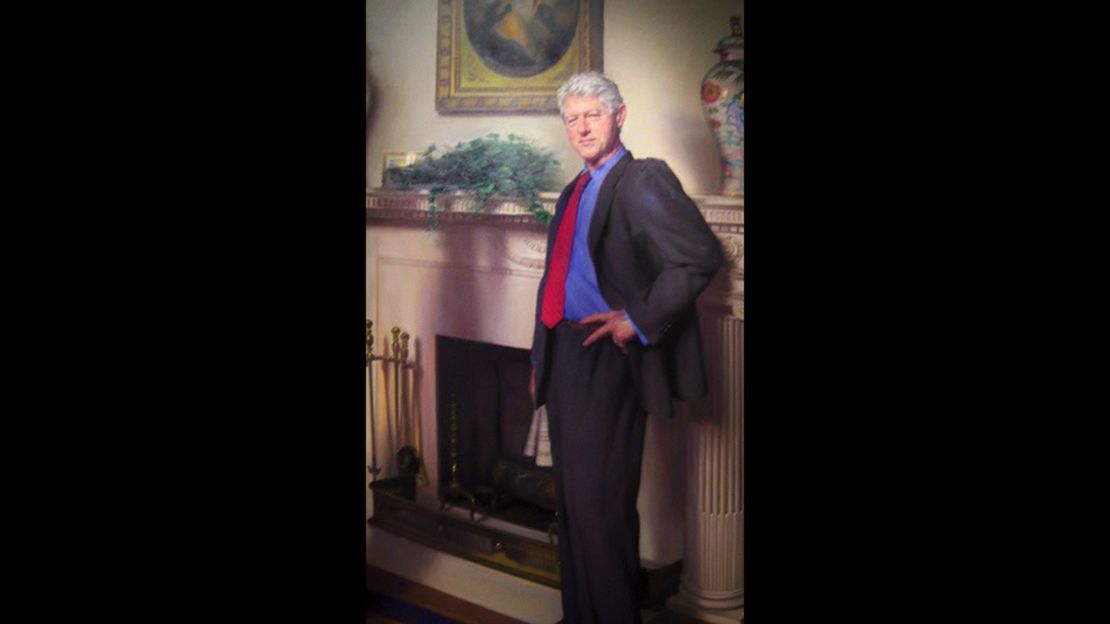Editor’s Note: Mat Gleason is a Los Angeles-based art critic. He is the founder of Coagula Art Journal and a regular contributor to the Huffington Post Arts Page.
Story highlights
Painter of Bill Clinton portrait, says shadow evokes Monica Lewinsky dress
Gleason: Clinton's two fingers might also have significance
Presence of newspaper will one day be element that most places portrait in time
Artists who take risks always risk a backlash.
Nelson Shanks, who painted the official portrait of President Bill Clinton, has been feeling the heat over his recent revelation that he hid some unflattering symbolism in the painting – a shadow on the fireplace mantle, supposedly cast by a blue dress. It was Shanks’ way of evoking Monica Lewinsky, the intern with whom Clinton had a scandalous fling while in office.

While the portrait is done in a conservative realistic style, the idea that the artist took risks in expressing his interpretation of the Clinton legacy is fascinating.
The shadow next to Clinton is unmistakably a figure and serves to scar the picture, much as the Lewinsky scandal scarred Clinton’s second term. But in a way it is sympathetic – a shadow is impermanent. It leaves no mark. It is not a lasting stain, which some critics of Clinton say the Lewinsky scandal left on the presidency itself.

But Shanks shows a wry humor in some other facets of the portrait. Since he has admitted the symbolism of the blue dress, it is natural to look more deeply at the work in search of other symbols.
For example, Clinton has two fingers conspicuously pointing outward at his waist. Could this be a commentary on there being two versions of the truth that he was known to deliver as it suited him? Much has been made of the absence of a wedding band on his hand, but the obviousness of the two fingers is unmistakable, and when the artist himself is pointing out the shadow of the blue dress as a metaphor, it is natural to wonder at their significance.
Clinton was the second American president to be impeached. Neither he nor Andrew Johnson were removed from office. Johnson’s presidential portrait by Washington B. Cooper reflects its times with no complex allegories adorning the historical record of the man himself. It is a sign of the era in which we live that painters have the freedom, and some would say temerity, to add pictorial interventions that are meant to stand as the historical visual record.
While artistic freedom is a hallmark of our country, Shanks is also making an artwork for a client. How much freedom he has to add his own commentary can be spelled out in a contract, but a true artist should stand above petty stipulations and make the artwork he or she truly believes in.
If the need to express the Lewinsky scandal compelled Shanks, we can only assume that we then have the best possible portrait of Clinton that this artist could have made. Had he been held to petty stipulations by a signed agreement, you can bet the portrait of our 42nd President would have been stiff and untrue. Censoring an artist with a contract ahead of time is as bad as banning the artwork after its release.
One thing everyone will probably agree on is that this portrait is already painfully dated. In his right hand Clinton holds a newspaper. Surely there are presently groups of Smithsonian museum-bound school children who will see the need to have a paper delivered with the days news as being the antiquated equal of a horse and buggy.
Monica’s shadow might end up reflecting an era where America’s morals were looser but that newspaper will probably be what makes the Clinton portrait seem as yesteryear as the founding fathers.
Read CNNOpinion’s new Flipboard magazine.































































